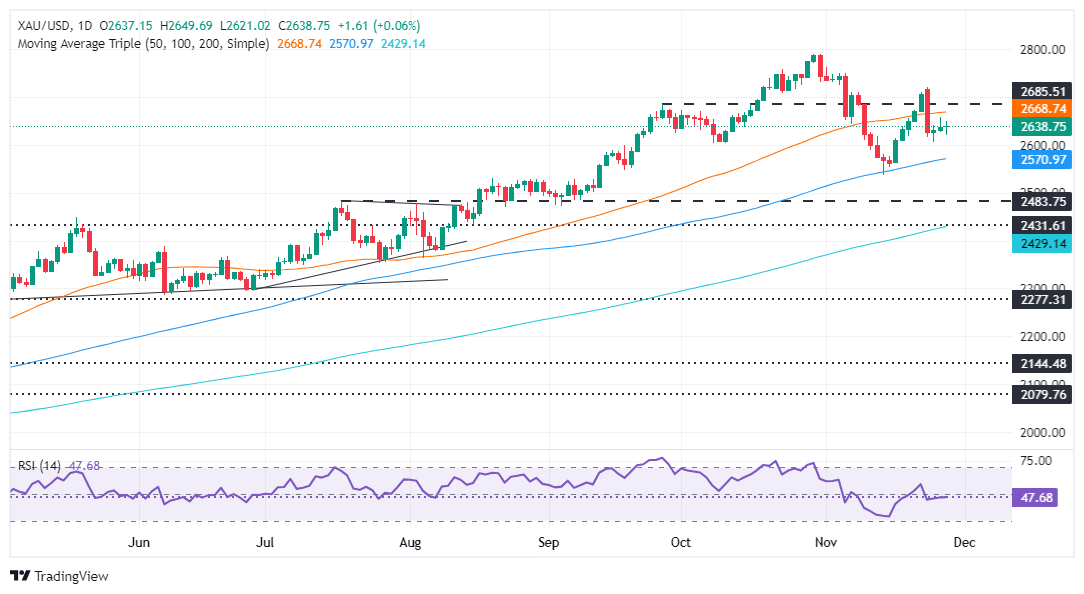- Gold price remains steady at $2,637 amid thin Thanksgiving trading.
- Trump's tariff threats weigh on Gold, but easing rhetoric towards Canada and Mexico offers some relief.
- Market eyes 70% chance of a 25 bps Fed rate cut, supporting gold as Treasury yields stay subdued.
Gold price consolidated around $2,630 on Thursday amid thin liquidity trading as US markets are closed for Thanksgiving. Geopolitics continued to drive the price of non-yielding metal, which dwindled during the last three trading days. The XAU/USD trades at $2,637, virtually unchanged.
Market mood improved on Thursday, partly due to Israel and Lebanon's 60-day ceasefire. However, the escalation of the Russia-Ukraine conflict could keep Bullion prices firmly above $2,600.
US President-elect Donald Trump's tariff threats on China, Canada, and Mexico limited the advance of the golden metal, with traders flying towards the safety of the Greenback. Sources cited by Reuters said, “It did increase a bit of concern about the possible repercussions from these two countries. So that continues to remain an important support factor for gold.”
Following Trump’s remarks, Gold tumbled due to risks linked to his threats. However, recent developments suggest that the US President-elect has eased his rhetoric to Canada and Mexico.
Gold recovered after the report and as market participants eyed another 25 basis point interest rate cut by the Federal Reserve at the upcoming December meeting.
The swaps market sees a probability of 70% of such a decision, according to the CME FedWatch Tool, as the odds improved from around 55% at the beginning of the week.
This would keep US Treasury bond yields depressed, which could undermine the Greenback.
Ahead this week, the US economic docket is absent, barring a surprise of a Federal Reserve speaker in the media. Next Monday, the schedule will be busy with the release of S&P Global and ISM Manufacturing PMI, and Fed Governor Christopher Waller crossing the wires.
Daily digest market movers: Gold prices fluctuate near $2,630
- Gold prices recovered as US real yields remained unchanged at 1.9906%.
- US data released on Wednesday showed the economy growing 2.8% in Q3, below estimates but unchanged from the preliminary estimate.
- This, along with the latest Core PCE Price for October coming at 2.8% YoY up from estimates of 2.7%, suggests the disinflation process has stalled and that the Fed might begin to pause cutting rates.
- Data from the Chicago Board of Trade, via the December fed funds rate futures contract, shows investors estimate 24 bps of Fed easing by the end of 2024.
Technical outlook: Gold price advances modestly, clings to $2,630
Gold price is consolidated within the 50 and 100-day Simple Moving Averages (SMAs), each at $2,668 and $2,572, respectively. Nevertheless, some upside in the short term is seen due to Gold’s being slightly pressed toward the former, but buyers need to clear key resistance levels.
If Gold clears the 50-day SMA, the next stop would be the $2,700 figure. A breach of the latter will expose the psychological $2,750, and the all-time high at $2,790.
Conversely, If bears push prices below $2,600, it will open the door to testing the 100-day SMA of $2,572, immediately followed by the November 14 swing low of $2,536.
Oscillators like the Relative Strength Index (RSI) have shifted bearishly, indicating sellers are in charge.
Fed FAQs
Monetary policy in the US is shaped by the Federal Reserve (Fed). The Fed has two mandates: to achieve price stability and foster full employment. Its primary tool to achieve these goals is by adjusting interest rates. When prices are rising too quickly and inflation is above the Fed’s 2% target, it raises interest rates, increasing borrowing costs throughout the economy. This results in a stronger US Dollar (USD) as it makes the US a more attractive place for international investors to park their money. When inflation falls below 2% or the Unemployment Rate is too high, the Fed may lower interest rates to encourage borrowing, which weighs on the Greenback.
The Federal Reserve (Fed) holds eight policy meetings a year, where the Federal Open Market Committee (FOMC) assesses economic conditions and makes monetary policy decisions. The FOMC is attended by twelve Fed officials – the seven members of the Board of Governors, the president of the Federal Reserve Bank of New York, and four of the remaining eleven regional Reserve Bank presidents, who serve one-year terms on a rotating basis.
In extreme situations, the Federal Reserve may resort to a policy named Quantitative Easing (QE). QE is the process by which the Fed substantially increases the flow of credit in a stuck financial system. It is a non-standard policy measure used during crises or when inflation is extremely low. It was the Fed’s weapon of choice during the Great Financial Crisis in 2008. It involves the Fed printing more Dollars and using them to buy high grade bonds from financial institutions. QE usually weakens the US Dollar.
Quantitative tightening (QT) is the reverse process of QE, whereby the Federal Reserve stops buying bonds from financial institutions and does not reinvest the principal from the bonds it holds maturing, to purchase new bonds. It is usually positive for the value of the US Dollar.
Information on these pages contains forward-looking statements that involve risks and uncertainties. Markets and instruments profiled on this page are for informational purposes only and should not in any way come across as a recommendation to buy or sell in these assets. You should do your own thorough research before making any investment decisions. FXStreet does not in any way guarantee that this information is free from mistakes, errors, or material misstatements. It also does not guarantee that this information is of a timely nature. Investing in Open Markets involves a great deal of risk, including the loss of all or a portion of your investment, as well as emotional distress. All risks, losses and costs associated with investing, including total loss of principal, are your responsibility. The views and opinions expressed in this article are those of the authors and do not necessarily reflect the official policy or position of FXStreet nor its advertisers. The author will not be held responsible for information that is found at the end of links posted on this page.
If not otherwise explicitly mentioned in the body of the article, at the time of writing, the author has no position in any stock mentioned in this article and no business relationship with any company mentioned. The author has not received compensation for writing this article, other than from FXStreet.
FXStreet and the author do not provide personalized recommendations. The author makes no representations as to the accuracy, completeness, or suitability of this information. FXStreet and the author will not be liable for any errors, omissions or any losses, injuries or damages arising from this information and its display or use. Errors and omissions excepted.
The author and FXStreet are not registered investment advisors and nothing in this article is intended to be investment advice.
Recommended content
Editors’ Picks

EUR/USD holds around 1.0300, with USD still dominating the scene
EUR/USD trades within familiar levels at around the 1.0300 mark, although the US Dollar pushes marginally higher in a quiet, holiday-inspired American session. Focus shifts to US Nonfarm Payrolls on Friday.

GBP/USD rebounds from multi-month lows, trades around 1.2300
GBP/USD trimmed part of its early losses and trades around 1.2300 after setting a 14-month-low below 1.2250. The pair recovers as the UK gilt yields correct lower after surging to multi-year highs on a two-day gilt selloff. Markets keep an eye on comments from central bank officials.

Gold hovers around $2.670, aims higher
Gold extended its weekly recovery and traded at its highest level since mid-December, above $2,670. The bright metal retreated modestly in a quiet American session, with US markets closed amid a National Day of Mourning.

Bitcoin falls below $94,000 as over $568 million outflows from ETFs
Bitcoin continues to edge down, trading below the $94,000 level on Thursday after falling more than 5% this week. Bitcoin US spot Exchange Traded Funds recorded an outflow of over $568 million on Wednesday, showing signs of decreasing demand.

How to trade NFP, one of the most volatile events Premium
NFP is the acronym for Nonfarm Payrolls, arguably the most important economic data release in the world. The indicator, which provides a comprehensive snapshot of the health of the US labor market, is typically published on the first Friday of each month.

Best Forex Brokers with Low Spreads
VERIFIED Low spreads are crucial for reducing trading costs. Explore top Forex brokers offering competitive spreads and high leverage. Compare options for EUR/USD, GBP/USD, USD/JPY, and Gold.
